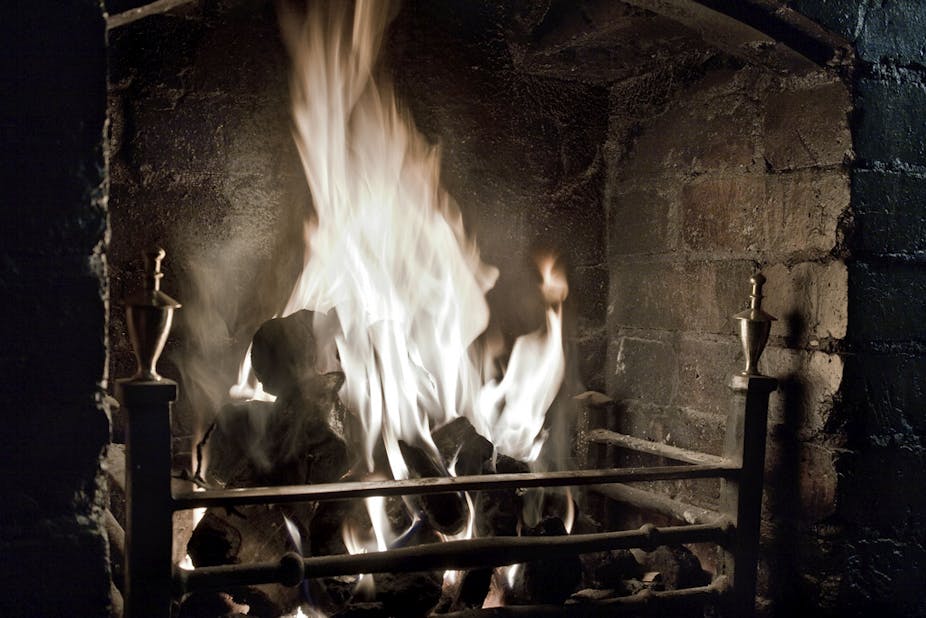At this time of year there’s nothing better than being warm and cosy in front of a blazing wood fire. But take a moment to walk outside and check your chimney - it could be polluting an entire neigbourhood.
I have to declare that I am ambivalent about this. I love nearly every aspect of wood heaters. The sight, the smell, the heat they produce, the link with a beautiful and living source of fuel.
When my family moved to Tasmania a few years ago, we found a lovely older style house with high ceilings and verandas that was heated with wood. The fire warmed the entire house and I was delighted with it. But there was a problem.
At the time of our move, I was completing a doctorate on the health effects of bushfire smoke – a small niche within the giant corpus of global research on the health effects of air pollution.
Smoke harms
Bushfire smoke and the smoke produced by wood heaters have much in common. They, along with tobacco smoke, are examples of biomass smoke – emissions that come from burning organic matter such as grass, leaves or wood.
Biomass smoke is a toxic soup of hundreds of different chemicals that includes many well-known toxins and carcinogens.
The population-wide health impacts of outdoor biomass smoke have been far less extensively studied than the more dominant causes of urban air pollution that mostly comes from burning fossil fuels for industry or transport. But the evidence is growing.
There’s absolutely no doubt about the harm woodsmoke does to lungs in those who are susceptible, from precipitating asthma and worsening existing respiratory diseases in the short term, to causing chronic lung diseases and lung cancer in the long term.

In cities where wood is the main fuel used for home heating, outdoor smoke pollution concentrations have been directly associated with hospital admissions for both heart and lung diseases. Even relatively brief (one or two days) exposure to outdoor biomass smoke from bushfires has a measurable impact on population health.
My research has shown that on days that Australian air quality standards were exceeded because of bushfire smoke, mortality rates increased by about 5%. And others have found that out-of-hospital cardiac arrests on such days increased by almost 50%.
Lessons from Tasmania
The Tasmanian city of Launceston achieved notoriety during the 1990s as one of Australia’s most severely polluted cities, with air quality that didn’t come anywhere close to meeting national air quality standards for most of winter.
A coordinated series of government interventions from 2001 included an education campaign to reduce the proportion of poorly operated heaters belching visible plumes of smoke, and a buy-back scheme that saw the absolute number of wood heaters fall by half.
The result was vastly improved air quality. The average winter concentration of particulate matter fell by 40% - an improvement large enough to see a substantial drop in mortality. Winter deaths from heart diseases were reduced by 20% and winter deaths from lung diseases fell by 28%.
In absolute numbers this translates into approximately 30 premature deaths avoided every year from the inner city population of 70,000 people.
Deaths are the extreme and uncommon end of the spectrum of health impacts from air pollution. But they represent the tip of the iceberg of community impacts. For every death avoided, there will also be far greater numbers of avoided hospital admissions, ambulance call outs, GP attendances, days unwell and absences from work or school.
Mitigating risks
In rural areas, wood is often readily available at minimal cost and represents the most affordable option for many people. Yet wood smoke clearly extracts a large health toll from the community, even in very small population centres.

So how can we minimise these impacts? The value of insulation and choosing energy efficient fuels are well documented but the immediate costs are beyond the reach of many families.
Systematic government programs clearly have a role and are likely to be highly cost effective. Individually, wood heater owners can do a huge amount to reduce the pollution they cause.
Even modern certified heaters are capable of producing orders of magnitude more pollution when burning inefficiently compared with bright, flaming, efficient use.
Inefficient burning results in the emissions of potent greenhouse gases such as methane and wastes energy that could otherwise be heating the home. You can find detailed advice on how to minimise pollution from your wood heater on many websites.
Probably the single most important thing to remember is to open the air vent fully each time new wood is added to the fire and then allow it to burn hot for 20 minutes before reducing the air intake. It’s especially important never to completely close the air intake.
If a flame is not present, wood gases – invisible in the fire box – will condense into microscopic particles that form thick smoke plumes that will continue to pollute your neighbourhood throughout the night while contributing very little heat to warm your home.
Smoke should almost never be visible from a working chimney, but I still count numerous thick plumes on my way home every night. We clearly have a long way to go before efficient operation of wood heaters becomes the norm.
I still love wood heaters, but owning one meant owning its pollution. Even if we achieved consistently prefect operation, I knew that other heating choices would be better for the environment and the community. We replaced our heater with a less polluting alternative. It’s a bit less evocative but does come on at the flick of a switch.

